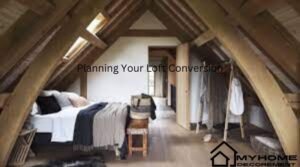A loft conversion is an excellent way to maximize your home’s potential, adding both space and value to your property. Whether you need an extra bedroom, a home office, or a playroom for the kids, converting your loft can provide the solution without the hassle and expense of moving. This comprehensive guide will take you through everything you need to know about loft conversions, from the initial planning stages to understanding the costs involved.
Why Consider a Loft Conversion?
A loft conversion is a practical and cost-effective way to expand your living space. With the increasing costs of property and the stress associated with moving, many homeowners are looking inward for space solutions. Loft conversions are particularly popular because they make use of the existing structure, often avoiding the need for significant extensions or new builds. Additionally, a well-executed loft conversion can increase your property’s value by up to 20%, making it a smart investment.
Planning Your Loft Conversion

Before embarking on a loft conversion, careful planning is crucial. The first step is to determine whether your loft is suitable for conversion. Most lofts can be converted, but factors such as the roof’s pitch, the height of the space, and the overall structure will influence the feasibility and cost.
- Assessing Your Space: Measure the height of your loft from the floor to the highest point of the ceiling. Ideally, you need a minimum height of 2.2 meters to ensure enough headroom once the conversion is complete.
- Choosing the Type of Conversion: There are several types of loft conversions to consider, each with its own advantages and potential drawbacks:
- Dormer Loft Conversion: This involves extending the existing roof to add space and headroom. Dormers are the most common type of loft conversion and can add a significant amount of usable floor space.
- Mansard Loft Conversion: A more extensive conversion that changes the structure of the roof, creating a nearly vertical wall at the back and a flat roof. Mansards offer substantial additional space but are more expensive and usually require planning permission.
- Hip to Gable Loft Conversion: Ideal for detached or semi-detached homes, this conversion extends the hip roof outwards to create a vertical gable wall, increasing the floor space.
- Velux Loft Conversion: The least invasive option, this type of conversion involves installing Velux windows into the existing roof slope. It’s a cost-effective option that doesn’t usually require planning permission but offers less additional space.
Obtaining Planning Permission

In many cases, loft conversions fall under permitted development rights and do not require planning permission. However, this depends on the specifics of your project and local regulations. For example, if your home is in a conservation area, or the conversion includes significant structural changes, you will likely need to apply for planning permission. Always check with your local planning authority before starting any work.
Design and Functionality

The design of your loft conversion should align with its intended use. Consider the following elements to ensure the space is both functional and aesthetically pleasing:
- Layout: Plan the layout carefully to make the most of the available space. Think about the positioning of windows to maximize natural light and the placement of stairs to ensure easy access without taking up too much room.
- Insulation and Ventilation: Proper insulation is crucial to make the loft a comfortable living space year-round. Similarly, good ventilation will prevent condensation and maintain air quality.
- Lighting: Natural light is a significant benefit of loft spaces, so large windows or skylights are essential. Additionally, consider the placement of electrical lighting to ensure the room is well-lit in the evenings.
- Storage: Make use of the eaves and other awkward spaces for built-in storage solutions. Custom-built cupboards and shelves can help keep the room organized without compromising on space.
- Interior Design: Choose colors and furnishings that make the space feel open and inviting. Light colors can help make the room feel larger, while multifunctional furniture can maximize usability.
Structural Considerations
A loft conversion involves significant structural work. Here are some key aspects to keep in mind:
- Roof Structure: Depending on the type of roof, additional support may be needed. Traditional roofs with rafters are usually easier to convert than modern trussed roofs, which might require reinforcement.
- Floor Strength: The existing ceiling joists are unlikely to be strong enough to support a new floor. Reinforcement or additional joists will be necessary to ensure the floor can bear the weight of the new room and its contents.
- Access and Safety: Building regulations require a safe and accessible staircase to the new loft room. The staircase must be designed to comply with regulations regarding width, headroom, and steepness. Additionally, smoke alarms and proper fire escape routes are essential for safety.
Costs Involved
The cost of a loft conversion can vary widely depending on several factors, including the type of conversion, the complexity of the design, and your location. On average, you can expect to pay between £20,000 and £60,000 for a standard loft conversion. Here’s a rough breakdown of costs:
- Basic Velux Conversion: Starting at around £20,000, this is the most affordable option. Costs increase with the addition of features like end-suite bathrooms.
- Dormer Conversion: Typically, costs between £30,000 and £50,000, depending on the size and complexity.
- Hip to Gable Conversion: Expect to pay between £40,000 and £65,000. This option involves significant structural changes and is more expensive.
- Mansard Conversion: The most costly option, ranging from £45,000 to over £70,000. It offers the most space but requires extensive work.
Financing Your Loft Conversion
Financing a loft conversion can be managed in several ways:
- Savings: Using personal savings is the most straightforward method, avoiding interest and loan fees.
- Home Improvement Loan: Many banks offer loans specifically for home improvement projects. Ensure you understand the interest rates and repayment terms.
- Remortgaging: You might consider remortgaging your home to release equity, providing a lump sum to fund the conversion.
- Government Grants: Check if you’re eligible for any government grants or schemes designed to improve energy efficiency or increase living space in your home.
Finding the Right Contractor
Choosing the right contractor is critical to the success of your loft conversion. Look for experienced professionals with a solid track record of completed loft conversions. Request detailed quotes from multiple contractors, and check references or reviews from previous clients. Ensure the contractor is fully insured and provides a comprehensive contract outlining the scope of work, timeline, and payment schedule.
Conclusion
A loft conversion is an exciting project that can significantly enhance your living space and increase your home’s value. By carefully planning and considering all aspects from design to costs, you can ensure a smooth and successful conversion. Whether you choose a simple Velux conversion or a more complex Mansard transformation, the key to success lies in thorough preparation, smart design choices, and selecting the right professionals to bring your vision to life.
Read also: check



